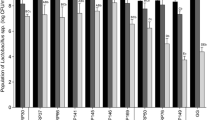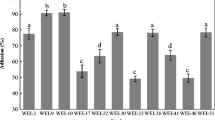Abstract
The aims of this research were to evaluate the safety and probiotic potential of Enterococcus spp. strains and select novel strains for future development of new functional fermented products. Bile salt hydrolase (BSH) activity, capacity of auto-aggregation and co-aggregation, hydrophobicity, tolerance to different pH values and NaCl content, mucin degradation, and antibiotic susceptibility were evaluated. Considering the preliminary probiotic features and safety, the strains were selected for complementary tests: tolerance to gastrointestinal tract (GIT) conditions, adhesion to Caco-2 cells and β-galactosidase activity, and presence of genes encoding virulence factors, antibiotic resistance, and biogenic amines were also performed for the selected strains. Enterococcus faecium SJRP20 and SJRP65 resisted well to the GIT conditions, presented low adhesion property, produced β-galactosidase although they did not present genes implicated in adhesion, aggregation, and colonization. Enterococcus faecium SJRP65 showed fewer genes related to antibiotic resistance and virulence factors and presented good functional properties, with interesting features for future application in dairy products.


Similar content being viewed by others
References
Acurcio LB, Souza MR, Nunes AC, Oliveira DLS, Sandes SHC, Alvim LB (2014) Isolation, enumeration, molecular identification and probiotic potential evaluation of lactic acid bacteria isolated from sheep milk. Braz J Vet Res Ann Sci 66:940–948
Adams CA (2010) The probiotic paradox: live and dead cells are biological response modifiers. Nut Res Rev 23:37–46
Ahmadova A, Todorov SD, Choiset Y, Rabesona H, Zadi TM, Kuliyev A, Franco BDGM, Chobert JM, Haertlé T (2013) Evaluation of antimicrobial activity, probiotic properties and safety of wild strain Enterococcus faecium AQ71 isolated from Azerbaijani Motal cheese. Food Control 30:631–641
Amaral DMF, Silva LF, Casarotti SN, Nascimento LCS, Penna ALB (2017) Enterococcus faecium and Enterococcus durans isolated from cheese: survival in the presence of medications, under simulated gastrointestinal conditions and adhesion properties. J Dairy Sci 100:933–949
Ashraf S, Shah N (2014) Immune system stimulation by probiotic microorganisms. Crit Rev Food Sci 54:938–956
Bautista-Gallego J, Jiménez-Días R, Arroyo-Lópes F, Fernandes AG (2013) Screening of lactic acid bacteria isolated from fermented table olives with probiotic potential. Food Res Int 50:135–142
Casarotti SN, Carneiro BM, Penna ALB (2014) Evaluation of the effect of supplementing fermented milk with quinoa flour on probiotic activity. J Dairy Sci 97:6027–6035
Casarotti SN, Carneiro BM, Todorov SD, Nero LA, Rahal P, Penna ALB (2017) In vitro assessment of safety and probiotic potential characteristics of Lactobacillus strains isolated from water-buffalo mozzarella cheese. Ann Microb 67:289–301
Cavalieri SJ, Rankin ID, Harbeck RJ, Sautter RL, McCarter YS, Sharp SE, Ortez JH, Spiegel CA (2005) Manual of antimicrobial susceptibility testing. American Society for Microbiology, Seattle
Chajęcka-Wierzchowska W, Zadernowska A (2016) Virulence factors, antimicrobial resistance and biofilm formation in Enterococcus spp. isolated from retail shrimps. LWT Food Sci Technol Int 69:117–122
Courvalin P (2006) Vancomycin resistance in Gram-positive cocci. Clin Infect Dis 42:S25–S34
de Paula AT, Jeronymo-Ceneviva AB, Silva LF, Todorov SD, Franco BDGM, Penna ALB (2014) Leuconostoc mesenteroides SJRP55: a potential probiotic strain isolated from Brazilian water buffalo mozzarella cheese. Ann Microb 65:899–910
Devriese L, Baele M, Butaye P (2006) The genus enterococcus In: Dworkin M, Falkow S, Rosenberg E, Schleifer KH, Stackebrandt E (eds) The prokaryotes: a handbook on the biology of bacteria. Vol. 4: Bacteria: Firmicutes, Cyanobacteria, 3rd Edn. Springer Science Business Media, New York, pp 163–174
Doyle RJ, Rosenberg M (1995) Measurement of microbial adhesion to hydrophobic substrata. Method Enzymol 253:542–550
Eaton TJ, Gasson MJ (2001) Molecular screening of Enterococcus virulence determinants and potential for genetic exchange between food and medical isolates. Appl Environ Microb 67:1628–1635
EFSA (2012) Guidance on the assessment of bacterial susceptibility to antimicrobials of human and veterinary importance EFSA journal 10:10 pp. https://doi.org/10.2903/j.efsa.2012.2740. Available online: www.efsa.europa.eu/efsajournal. Accessed 28 July 2016
EFSA (2017) Scientific opinion on the update of the list of QPS-recommended biological agents intentionally added to food or feed as notified to EFSA Journal 1:178 pp. https://doi.org/10.2903/j.efsa.2017.4664. Available online: www.efsa.europa.eu/efsajournal. Accessed 30 Sept 2018
FAO/WHO (2002) Guidelines for the evaluation of probiotics in food: report of a joint FAO/WHO working group on drafting guidelines for the evaluation of probiotics in food. London
Favaro L, Penna ALB, Todorov SD (2015) Bacteriocinogenic LAB from cheeses—application in biopreservation? Trends Food Sci Technol 41:37–48
Gaglio R, Couto N, Marques C, Lopes MFS, Moschetti G, Pomba C, Settanni L (2016) Evaluation of antimicrobial resistance and virulence of enterococci from equipment surfaces, raw materials, and traditional cheeses. Int J Food Microbiol 236:107–114
Gheytanchi E, Heshmati L, Shargh BK, Nowroozi J, Movahedzadeh F (2010) Study on β-galactosidase enzyme produced by isolated lactobacilli from milk and cheese. Afr J Microbiol Res 4:454–458
Guerrero-Ramos E, Molina-González D, Blanco-Morán S, Igrejas G, Poeta P, Alonso-Calleja C, Capita R (2016) Prevalence, antimicrobial resistance, and genotypic characterization of vancomycin-resistant Enterococci in meat preparations. J Food Protect 79:748–756
Hanchi H, Mottawea W, Sebei K, Hammami R (2018) The genus Enterococcus: between probiotic potential and safety concerns-an update. Front Microbiol 9:1–16
Hummel A, Holzapfel WH, Franz CMAP (2007) Characterization and transfer of antibiotic resistance genes from enterococci isolated from food. Syst Appl Microbiol 30:1–7
Hwanhlem N, Biscola V, El-Ghaish S, Jaffrès E, Dousset X, Haertlé T, Kittikun AH, Chobert JC (2013) Bacteriocin-producing lactic acid bacteria isolated from mangrove forests in southern Thailand as potential bio-control agents: purification and characterization of bacteriocin produced by Lactococcus lactis subsp. lactis KT2W2L. Probiotics Antimicrob Proteins 5:264–278
Jeronimo-Ceneviva AB, De Paula AT, Silva LF, Todorov SD, Franco BDGM, Penna ALB (2014) Probiotic properties of lactic acid bacteria isolated from water-buffalo mozzarella cheese. Probiotics Antimicrob Proteins 6:141–156
Jiménez E, Ladero V, Chico I, Maldonado-Barragán A, López M, Martín V, Fernández L, Fernández M, Álvarez MA, Torres C, Rodríguez JM (2013) Antibiotic resistance, virulence determinants and production of biogenic amines among enterococci from ovine, feline, canine, porcine and human milk. BMC Microbiol 13:1–12
Kos B, Suskovic J, Vukovic S, Simpraga M, Frece J, Matosic S (2003) Adhesion and aggregation ability of probiotic strain Lactobacillus acidophilus M92. J Appl Microbiol 94:981–987
Kumar R, Grover S, Batish VK (2012) Bile salt hydrolase (BSH) activity screening of Lactobacilli: in vitro selection of indigenous Lactobacillus strains with potential bile salt hydrolysing and cholesterol-lowering ability. Probiotics Antimicrob Proteins 4:162–172
Li B, Zhan M, Evivie SE, Jin D, Zhao L, Chowdhury S, Sarker SK, Huo G, Liu F (2018) Evaluating the safety of potential probiotic Enterococcus durans KLDS6.0930 using whole genome sequencing and oral toxicity study. Front Microbiol 9:1–15
Liong MT, Shah NP (2006) Effects of a Lactobacillus casei synbiotic on serum lipoprotein, intestinal microflora, and organic acids in rats. J Dairy Sci 89:1390–1399
Martin B, Garriga M, Hugas M, Aymerich T (2005) Genetic diversity and safety aspects of enterococci from slightly fermented sausages. J Appl Microbiol 98:1177–1190
Martín-Platero AM, Valdivia E, Maqueda M, Martínez-Bueno M (2009) Characterization and safety evaluation of enterococci isolated from Spanish goats’ milk cheeses. Int J Food Microbiol 132:24–32
Matos R, Pinto VV, Ruivo M, Lopes MF (2009) Study on the dissemination of the bcrABDR cluster in Enterococcus spp. reveals that the BcrAB transporter is sufficient to confer high-level bacitracin resistance. Int J Antimicrob Agents 34:142–147
Penna ALB, de Paula AT, Casarotti SN, Silva LF, Diamantino VR, Todorov SD (2015). Overview of the functional lactic acid bacteria in fermented milk products. In: Rai R and Bai JA (eds) Beneficial microbes in fermented and functional foods. CRC Press: Taylor and Francis Group, Boca Raton, pp 113–149
Peres CM, Alves M, Hernandez-Mendoza A, Moreira L, Silva S, Bronze MR, Vilas-Boas L, Peres C, Malcata FX (2014) Novel isolates of lactobacilli from fermented Portuguese olive as potential probiotics. LWT Food Sci Technol 59:234–246
Perin LM, Miranda RO, Todorov SD, Franco BDGM, Nero LA (2014) Virulence, antibiotic resistance and biogenic amines of bacteriocinogenic lactococci and enterococci isolated from goat milk. Int J Food Microbiol 185:121–126
Pingitore EV, Todorov SD, Sesma F, Franco BDGM (2012) Application of bacteriocinogenic Enterococcus mundtii CRL35 and Enterococcus faecium ST88Ch in the control of Listeria monocytogenes in fresh Minas cheese. Food Microbiol 32:38–47
Ranadheera CS, Evans CA, Adams MC, Baines SK (2012) In vitro analysis of gastrointestinal tolerance and intestinal cell adhesion of probiotics in goat’s milk ice cream and yogurt. Food Res Int 49:619–625
Sánchez-Ortiz AC, Luna-González A, Campa-Córdova AI, Escamilla-Montes R, Flores-Miranda MDC, Mazón-Suástegui JM (2015) Isolation and characterization of potential probiotic bacteria from pustulose ark (Anadara tuberculosa) suitable for shrimp farming. Lat Am J Aquat Res 43:123–136
Sánchez-Valenzuela A, Benomar N, Abriouel H, Cañamero MM, Gálvez A (2010) Isolation and identification of Enterococcus faecium from seafoods: antimicrobial resistance and production of bacteriocin-like substances. Food Microbiol 27:955–961
Santos KMO, Vieira ADS, Salles HO, Oliveira JS, Rocha CRC, Borges MF, Bruno LM, Franco BDGM, Todorov SD (2015) Safety, beneficial and technological properties of Enterococcus faecium isolated from Brazilian cheeses. Braz J Microbiol 46:237–249
Sattari M (2009) Prevalence of ant(4′)-Ia gene among clinical isolates of methicillin-resistant Staphylococcus aureus using multiplex-PCR method. Pathol Res Pract 12:59–68
Sauer P, Síla J, Vágnerová I (2009) Virulence factors in vancomycin-susceptible and vancomycin-resistant enterococci in the university hospital Olomouc. Klin Mikrobiol Infekc Lek J 15:44–47
Silva LF (2015) Diversity and evolution of authocthonous lactic microbiota in water buffalo Mozzarella cheese and technological application of isolates. Ph D Thesis, São Paulo State University
Silva LFS, Casella T, Gomes ESG, Nogueira MCL, Lindner JD, Penna ALB (2015) Diversity of lactic acid bacteria isolated from Brazilian water buffalo mozzarella cheese. J Food Sci 80:411–417
Taheri HR, Moravej H, Tabndeh F, Zaghari M, Schivazad M (2009) Screening of lactic acid bacteria toward their selection as a source of chicken probiotic. Poult Sci 88:1586–1593
Todorov SD, Botes M, Guigas C, Schillinger U, Wiid I, Wachsman MB, Holzapfel WH, Dicks LM (2008) Boza, a natural source of probiotic lactic acid bacteria. J Appl Microbiol 104:465–477
Todorov SD, Furtado DN, Saad SM, Tome E, Franco BD (2011) Potential beneficial properties of bacteriocin-producing lactic acid bacteria isolated from smoked salmon. J Appl Microbiol 110:971–986
Todorov SD, Franco BDGM, Wiid IJ (2014) In vitro study of beneficial properties and safety of lactic acid bacteria isolated from Portuguese fermented meat products. Benef Microbes 5:351–366
Vandeplans Y, Huys G, Daube G (2015) Probiotics: an update. J Pediatria 91:6–21
Zhou JS, Gopal PK, Gill HS (2001) Potential probiotic lactic acid bacteria Lactobacillus rhamnosus (HN001), Lactobacillus acidophilus (HN017) and Bifidobacterium lactis (HN019) do not degrade gastric mucin in vitro. Int J Food Microbiol 63:81–90
Zommiti M, Cambronel M, Maillot O, Barreau M, Sebei K, Feuilloley M, Ferchichi M, Connil N (2018) Evaluation of probiotic properties and safety of Enterococcus faecium isolated from artisanal Tunisian meat “dried Ossban”. Front Microbiol 9:1685. https://doi.org/10.3389/fmicb.2018.01685
Acknowledgments
The authors would also like to thank Dr. José Manoel de Moura Filho for his assistance with statistical analysis.
Funding
Fundação de Amparo à Pesquisa do Estado de São Paulo (FAPESP, Brazil, Project N° 2014/02131-8), Conselho Nacional de Desenvolvimento Científico e Tecnológico (CNPq, Brazil, Project 307155/2015–3) and Coordenação de Aperfeiçoamento de Pessoal de Nível Superior (CAPES, Brazil).
Author information
Authors and Affiliations
Corresponding author
Ethics declarations
Conflict of interest
The authors declare that they have no conflict of interest.
Research involving human participants and/or animals
Not applicable.
Informed consent
Not applicable.
Additional information
Publisher’s Note
Springer Nature remains neutral with regard to jurisdictional claims in published maps and institutional affiliations.
Rights and permissions
About this article
Cite this article
Nascimento, L.C.S., Casarotti, S.N., Todorov, S.D. et al. Probiotic potential and safety of enterococci strains. Ann Microbiol 69, 241–252 (2019). https://doi.org/10.1007/s13213-018-1412-5
Received:
Accepted:
Published:
Issue Date:
DOI: https://doi.org/10.1007/s13213-018-1412-5




